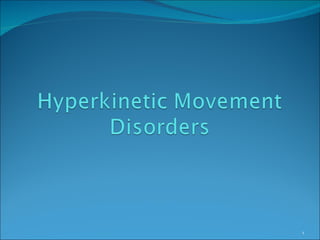Movement disorders lecture
•Transferir como PPT, PDF•
119 gostaram•31,994 visualizações
T
testMovement disorders lecture
Denunciar
Compartilhar
Denunciar
Compartilhar

Recomendados
Recomendados
Mais conteúdo relacionado
Mais procurados
Mais procurados (20)
Ataxia : causes, symptoms, diagnosis and treatment

Ataxia : causes, symptoms, diagnosis and treatment
Semelhante a Movement disorders lecture
Semelhante a Movement disorders lecture (20)
practical approach to movement disorders by M.Habeel.pdf

practical approach to movement disorders by M.Habeel.pdf
hyperkinetic dysarthria N.pptx lecture dysarthria lecture

hyperkinetic dysarthria N.pptx lecture dysarthria lecture
CEREBRAL PALSY.pptx by John wambugu ..a clinical officer paediatrician

CEREBRAL PALSY.pptx by John wambugu ..a clinical officer paediatrician
Mais de test
Mais de test (10)
Recombinant protein expression and purification Lecture

Recombinant protein expression and purification Lecture
Último
https://app.box.com/s/7hlvjxjalkrik7fb082xx3jk7xd7liz3TỔNG ÔN TẬP THI VÀO LỚP 10 MÔN TIẾNG ANH NĂM HỌC 2023 - 2024 CÓ ĐÁP ÁN (NGỮ Â...

TỔNG ÔN TẬP THI VÀO LỚP 10 MÔN TIẾNG ANH NĂM HỌC 2023 - 2024 CÓ ĐÁP ÁN (NGỮ Â...Nguyen Thanh Tu Collection
God is a creative God Gen 1:1. All that He created was “good”, could also be translated “beautiful”. God created man in His own image Gen 1:27. Maths helps us discover the beauty that God has created in His world and, in turn, create beautiful designs to serve and enrich the lives of others.
Explore beautiful and ugly buildings. Mathematics helps us create beautiful d...

Explore beautiful and ugly buildings. Mathematics helps us create beautiful d...christianmathematics
Último (20)
Mixin Classes in Odoo 17 How to Extend Models Using Mixin Classes

Mixin Classes in Odoo 17 How to Extend Models Using Mixin Classes
Role Of Transgenic Animal In Target Validation-1.pptx

Role Of Transgenic Animal In Target Validation-1.pptx
Food Chain and Food Web (Ecosystem) EVS, B. Pharmacy 1st Year, Sem-II

Food Chain and Food Web (Ecosystem) EVS, B. Pharmacy 1st Year, Sem-II
Beyond the EU: DORA and NIS 2 Directive's Global Impact

Beyond the EU: DORA and NIS 2 Directive's Global Impact
Unit-V; Pricing (Pharma Marketing Management).pptx

Unit-V; Pricing (Pharma Marketing Management).pptx
Measures of Central Tendency: Mean, Median and Mode

Measures of Central Tendency: Mean, Median and Mode
TỔNG ÔN TẬP THI VÀO LỚP 10 MÔN TIẾNG ANH NĂM HỌC 2023 - 2024 CÓ ĐÁP ÁN (NGỮ Â...

TỔNG ÔN TẬP THI VÀO LỚP 10 MÔN TIẾNG ANH NĂM HỌC 2023 - 2024 CÓ ĐÁP ÁN (NGỮ Â...
Micro-Scholarship, What it is, How can it help me.pdf

Micro-Scholarship, What it is, How can it help me.pdf
Seal of Good Local Governance (SGLG) 2024Final.pptx

Seal of Good Local Governance (SGLG) 2024Final.pptx
Web & Social Media Analytics Previous Year Question Paper.pdf

Web & Social Media Analytics Previous Year Question Paper.pdf
General Principles of Intellectual Property: Concepts of Intellectual Proper...

General Principles of Intellectual Property: Concepts of Intellectual Proper...
Explore beautiful and ugly buildings. Mathematics helps us create beautiful d...

Explore beautiful and ugly buildings. Mathematics helps us create beautiful d...
Movement disorders lecture
- 6. Ballismus Dystonia Chorea Athetosis Movements become - Less violent / explosive / jerky - Smoother and more flowing - More sustained They differ from tics in that they cannot be suppressed by voluntary control Myoclonus
- 17. Athetosis is a slow continuous stream of slow, sinuous, writhing movements, typically of the hands and feet. Most commonly seen together with chorea in dyskinetic motor fluctuations in PD . Also in athetoid cerebral palsy where damage occurs in the basal ganglia. Related to excessive dopaminergic activity . In PD reducing dopaminergic drugs alleviates. If Athetosis becomes faster, it sometimes blends with chorea, ie choreoathetosis/ 'choreo-athetoid' movements. Can be thought of as an athetoid movement that “gets stuck” for a period of time; thus, a patient with choreoathetosis may perform an involuntary movement in which his hand and fingers are twisted behind his head. He may hold this position for a few moments before his hand moves back in front of his body. The part of the movement when the limb was held, unmoving, in an abnormal position would be considered a dystonia (may occur alone). Athetosis Athetosis Video: http://www.youtube.com/watch?v=J_wIDm1_ax4&feature=related
- 20. Extra material to read latter-Dystonia: Etiology Causes: Primary dystonia refers to the situation where dystonia is the only sign and there is no identifiable cause or structural abnormality in the central nervous system. Although the causes of dystonia are not fully known it is currently thought that the condition results from a malfunction in a part of the brain called the basal ganglia. The problem may mainly lie in an area of the basal ganglia called the globus pallidus. If this area of the brain is not functioning correctly then the control of another structure in the brain called the thalamus is affected. The thalamus controls the planning and execution of movement and sends nerves to muscles via the spinal cord. The end result is that muscle co-ordination is not regulated properly. The wrong muscles will contract on movement or all muscles will contract unnecessarily causing abnormal movement and posture. Secondary dystonia implies there is a clear cause, such as a change in the structure of the brain, an environmental cause, as part of an inherited or acquired neurological disease or due to drugs or toxins. Environmental causes include head trauma, stroke, a tumour, multiple sclerosis, infections in the brain, injury to the spinal cord, or after chemotherapy, drugs ( neuroleptics-Tardive dystonia ) or toxins that affect the basal ganglia, thalamus or brain stem. They may be associated with other hereditary neurological syndromes. Dystonia may be the first sign in a patient with Huntington's disease, and is secondary to many other neurological diseases including Parkinson's disease, Wilson's disease and Ataxia telangiectasia.
Notas do Editor
- VCP3042; 1st August 2008 [email_address]
- VCP3042; 1st August 2008 [email_address] Early massive loss of striatopallidal and then striatonigral neurones; excitotoxicity